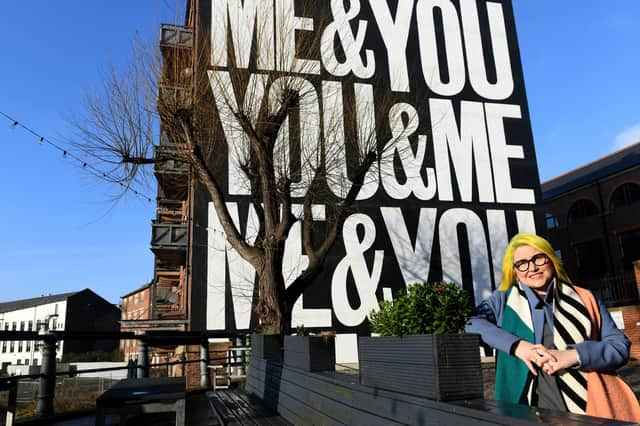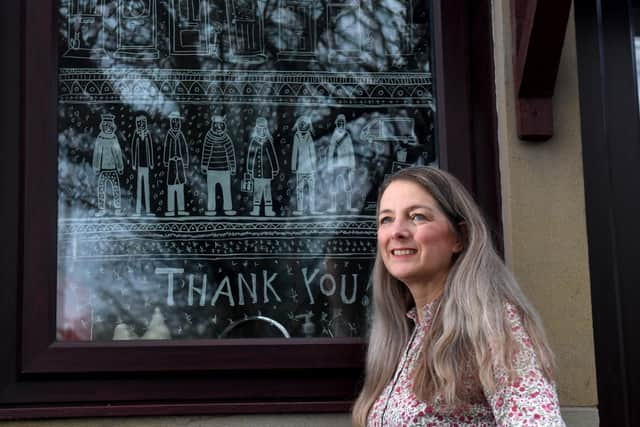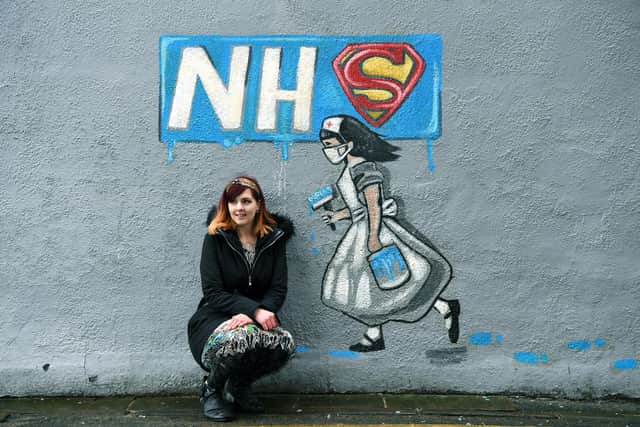“Art made art”: how the pandemic turned Yorkshire’s streets into outdoor galleries


Confined to her home for most of 2020, Amanda Danells-Bewley decided to finally act on the windows through which three separate neighbours could see into her home.
Rather than install curtains or blinds, however, she opted for something different altogether: using chalk pens to draw elaborate, swirling patterns across the glass; obscuring the interior view while also giving outsiders something pretty to look at.
Advertisement
Hide AdAdvertisement
Hide AdAs restrictions continued, Amanda decided to change up the windows with a different theme each month, eventually migrating designs to the front windows too, where she and her family left messages of gratitude to the delivery drivers who make regular visits to the doorstep. “People just need a bit of positivity and light”, says Amanda.


It’s one small act of creativity that reflects a much wider, continuing trend across the country: when the pandemic forced people indoors last March, they took to their windows, gardens and back yards to communicate messages of hope, thanks and joy to the world they were suddenly shut off from.
Children scrawled rainbows on every available surface, artworks cropped up on driveways and millions pinned up posters bearing messages of thanks to the key workers keeping the country going.
Perhaps most ubiquitous - and enduring - are these key worker-dedicated posters whose brightly-coloured slogans have become a familiar sight across Britain.
Advertisement
Hide AdAdvertisement
Hide AdThe posters, bearing messages like “Essentially amazing - thank you”, and “You are all going to deserve medals after this” in fact began their life in Yorkshire, the brainchild of curator and In Good Company founder, Laura Wellington.


When first launching the project - named “Posters for the People” - Laura was simply looking for “a way to say thank you” to essential workers, gathering together local artists who produced the designs for free before disseminating the posters across Leeds.
Wondering if she could take the concept one step further by fundraising, Laura and her team then tentatively launched a web shop for people to purchase the posters online.
Within weeks, they’d shipped orders across the globe: Canada, Italy, Australia and New Zealand. Posters were spotted in windows up and down the UK, from the far north of Scotland to the southernmost tip of Cornwall.
Advertisement
Hide AdAdvertisement
Hide AdThe posters - and their message - quickly snowballed beyond windows, spawning collaborations with a chocolate bar company, North Brewing Co. and even a distillery, who created an essential worker gin to raise money for good causes.
“It just went absolutely bonkers...we just didn’t expect it to be received like that”, explains Laura, who says that the project has received scores of positive feedback from NHS workers, bus drivers and other key workers.
“Before, when life was so busy and chaotic, it was difficult to really take things in”, says Laura, who believes that the posters’ roaring success can be put down to the slowed-down pace of life brought about by the pandemic:
“Once life is stripped back to the bare essentials, you start to pick up on the small things that bring you joy”.
Advertisement
Hide AdAdvertisement
Hide AdIt’s a sentiment that Rachel List, a muralist from Pontefract, echoes, saying that the spirit of the first lockdown would “be impossible to create again”.
Usually an indoor mural painter, Rachel found herself out of work during March 2020, and when approached about painting NHS-themed artwork on the outside wall of a pub, she took the job on hesitantly:
“I was a bit reluctant at first - I didn’t even tell my friends I was doing it...but I got this overwhelming sense that it was really needed”.
It wasn’t until the mural began trending on Twitter as an alleged Banksy that Rachel realised how well her mural - combining the superman and NHS logos - had been received.
Advertisement
Hide AdAdvertisement
Hide Ad“I revealed myself as the artist and suddenly I was inundated with messages from people asking me to paint their walls.
“It’s not in many people’s lifetimes that you get to make such a strong impact on the place you live - I didn’t just paint the town red, I painted it every colour of the rainbow”.
Much like Laura, Rachel’s original intention was to boost the morale of essential workers, but the actual impact was much wider: after painting 12 murals across Pontefract - a town not usually known for street art - the paintings were turned into a “rainbow trail” for families to follow on their daily walks.
“I got loads of feedback from families who said that [the trail] was the thing they looked forward to on their daily walk - that was really surprising to me”.
Advertisement
Hide AdAdvertisement
Hide AdIt’s just one example, says Laura, of the “knock-on effects” that street art has on a community beyond the obvious aesthetic benefits.
One of the benefits is economic, says Laura, who points to an example she witnessed after commissioning a recent seven story high Anthony Burrill mural in Leeds:
“A local photographer came and took pictures, put them online, and people immediately started asking for prints - so he set up a web shop to sell them...that’s a direct, local economic benefit to [having] the artwork”.
She adds, too, that In Good Company’s future plans involve joining up Leeds’ street art with local independent businesses, with the aim of generating further local profits:
Advertisement
Hide AdAdvertisement
Hide Ad“[Street art] just has so many knock-on effects, so many layers”, explains Laura. “It makes an area feel safer….it inspires other artists, and then art makes art!”
What’s more, says Laura, an increased prevalence of street art transforms the usual ways in which we see and consume art:
“If you don’t feel comfortable going into an art gallery or you don’t have the money...street art brings art to everybody”.
It struck such a note during the pandemic, says Laura, not only because of heightened attention to our local areas, but also because we’re a society accustomed to being constantly advertised to:
Advertisement
Hide AdAdvertisement
Hide Ad“We’re so used to being constantly sold stuff...in our [Posters for the People] takeover we took over sites usually used for advertising.
“For art to be taking up space where you would normally be sold things…I think that really changed the way people looked at the streets, it really brightened up people’s days”.
It’s a transformation that Laura hopes will endure beyond the pandemic, with people “realising how important [outdoor art] is and how much it changes a place...I’ve been banging the drum about this for years, so I’m glad the shift is taking place”. During the current lockdown, she’s gone back to the drawing board, looking at “what Posters for the People 2.0 might look like”.
Though Rachel fears that the second lockdown has been greeted by a more pessimistic, distrustful public, she echoes Laura’s hope that street art will endure as a silver lining of the pandemic:
“There’s been a new-found appreciation for art. No, it’s not essential, but people have realised we need more than just the essentials in life”.